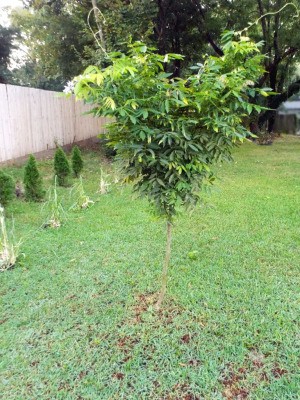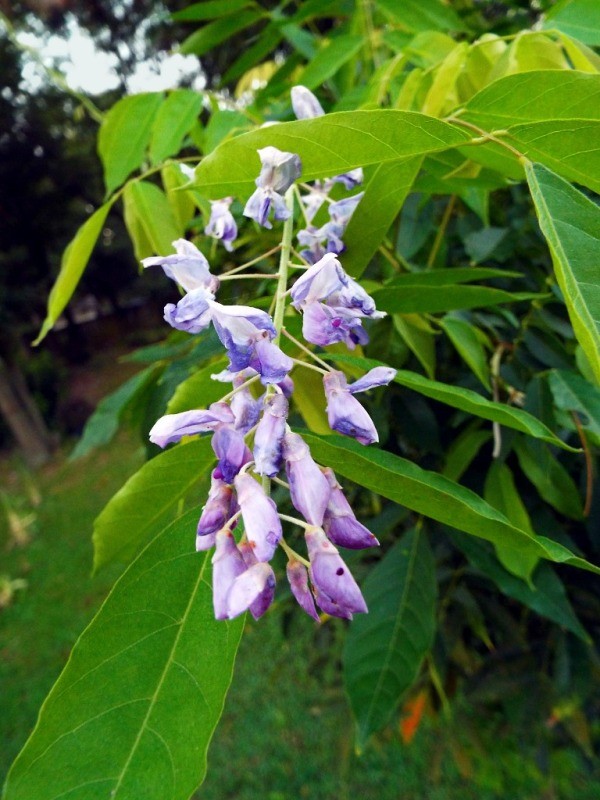 Some varieties of wisteria have a raceme (a particular type of bloom), that can be as long as 30 inches and covered with over a hundred flowers. The variety I'm growing has a raceme averaging 12-18 inches and is covered with many fully developed flowers. So why would I post a picture of what appears to be a little, underdeveloped raceme? I thought you'd ask.
Some varieties of wisteria have a raceme (a particular type of bloom), that can be as long as 30 inches and covered with over a hundred flowers. The variety I'm growing has a raceme averaging 12-18 inches and is covered with many fully developed flowers. So why would I post a picture of what appears to be a little, underdeveloped raceme? I thought you'd ask.
About 21 years ago, I was walking down a street where wisteria were growing to one side. They had bloomed earlier and now were dispersing their seed pods. The walk was littered with hundreds of them. I collected a few and brought them home.
I planted several seed in small pots rather than in the open ground. My plan was to grow these wisteria as standards (having a tree like, rather than running vine, habit). I wanted to keep them small and I knew the small pots would help keep their size in check.
Over the years, the plants grew to a height of about 6 feet and stayed at that height for several more years. I thought that by the fifth year I would have seen blooms. My heart would break a little each year as wisteria bloom time would come and go and there were no flowers.
After 18 years of caring for these plants and still no blooms, I removed them from their pots and planted them in the ground where they grew vigorously. Even with such vigorous growth, years 19 and 20 came and went, and still no blooms.
Today, I was watering some newly planted Pampas grass when something caught my eye. What!? Could this be? I saw a bloom on one of my wisterias. Small and underdeveloped, but a bloom.
Unchecked wisteria growing in the wild can attain a height of a hundred feet or more and be somewhat invasive, almost like kudzu. I didn't have room for, nor did I want a plant of that size. Checking their growth in pots was a good idea, but I overdid it, hence the 21 year wait. Had I grown them in 5 gallon buckets, I probably would have had blooms within 5 years.
My tip: If you plan to grow wisteria from seed (or small cuttings), and have them develop into standards, be sure to plant them in at least 5 gallon buckets. An exception for planting them in small pots would be if you want a bonsai. And truth be known, they make some of the most beautiful bonsai you will ever see.
Come this spring, I expect these wisteria to be covered in blooms. In following years, I expect them to take on a beautiful appearance, not unlike a large and ancient bonsai.
Twenty-one years, people, twenty-one years. Be happy for me!
Share on ThriftyFunThis page contains the following solutions. Have something to add? Please share your solution!
A lot of unusual things happen in the garden. I would wager most go unnoticed by most gardeners. I find these odd happenings interesting and I like to share them on ThriftyFun.
The wisteria is not a tree. It is a vigorously growing and often invasive vine. It can be kept in check by training it to grow as a standard, whereby it takes on the appearance of a small tree.
Ask a QuestionHere are the questions asked by community members. Read on to see the answers provided by the ThriftyFun community or ask a new question.
I am trying to make my wisteria vine grow into a tree. How can I get the trunk to thicken?
I absolutely love Wisteria but I have so many trees that it's difficult to find a place to plant a vine or even a 'tree' and know that it will have plenty of room to grow and not do any harm to my trees or structures. I do have several (2 in containers) but I have to keep them cut back so they never really grow to their potential.
If your Wisteria is already planted be sure to take all these things into consideration before moving on.
As to thickening the trunk, this may be a slow process but I have noticed mine slowly increasing in size each year.
Check out the links for more information.
There are so many good sites explaining how to turn your Wisteria into a tree/standard that it would be waste of space to write it all down here.
I have heard that one of the biggest mistakes people make when starting this project is using too small of a support post.
Information:
"After planting the vine, install a 4 x 4 wooden post or a metal fence post to a depth of at least 12 to 18 inches in the ground with 4 to 5 feet or so of the post above ground.
Here are a couple of links that provide detailed instructions on turning your Wisteria into a tree/standard as well as other information. Some articles are long but good reading on how to do this. Each site has usuful information.
dengarden.com/
dengarden.com/
www.whiteflowerfarm.com/
www.wilsonbrosgardens.com/
Actually this genus should have be named Wistaria, and not Wisteria, as it was named in honor of Professor Caspar Wistar of the University of Pennsylvania, but an unfortunate misspelling while registering has for ever kept the name Wisteria.
Wisteria can be invasive, but all vines can be invasive, it's in their nature to reach a position where they can take advantage of light. Chinese wisteria (Wisteria sinensis) and Japanese wisteria (Wisteria floribunda) are not native to North America and are considered invasive species in some states.
Remember that all parts of the wisteria plant contain substances called lectin and wisterin, which are toxic to pets, livestock, and humans. These toxins can cause from nausea and diarrhea to death if consumed in large amounts.
Select good and named variety, do not take a vine of an unknown variety, as it most likely will be seed raised, which will result only in disappointment. Asian wisteria is aggressive growers with fuzzy seed pods, while North American wisteria are not quite as aggressive in their growing habits. Some gardening books say that the Chinese varieties have stems which twine clockwise, Japanese forms twine in a counter clockwise.
Wisteria rarely blooms if there is rich soil, success comes with proper pruning.
To grow and train your Wisteria use a support post and prune back Wisteria fearlessly:
1st pruning in July, cutting all whips and stems back to the main trunk, leaving a foot or so of stem which can be allowed to form buds for the following year;
2nd pruning in early spring, or late winter, just before the vines start to grow and flower buds begin to swell growingwithplants.com/
"Do not wind the main stem around the support post as it grows. This will result in a weakly stemmed tree, unable to support future growth." Here is a detailed description of how to train Wisteria: homeguides.sfgate.com/